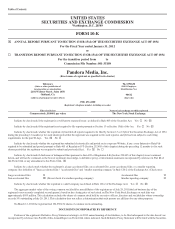Pandora 2012 Annual Report Download - page 21
Download and view the complete annual report
Please find page 21 of the 2012 Pandora annual report below. You can navigate through the pages in the report by either clicking on the pages listed below, or by using the keyword search tool below to find specific information within the annual report.
Table of Contents
terrestrial radio broadcasters. Further, the Copyright Office has issued a report with respect to whether sound recordings released in the United States prior to
January 1972 (the time at which federal copyright protection was first afforded to sound recordings), should be covered under federal copyright law. The
report recommended that federal copyright protection should apply to sound recordings fixed before February 15, 1972. It proposed special provisions to
address issues such as copyright ownership, term of protection, termination of transfers and copyright registration. We do not expect any potential resulting
legislation to have a material impact on our business, financial condition or results of operations. We are not aware of any other proposed or pending changes
to laws and regulations relating to performance royalties applicable to commercial webcasters such as us.
Musical Compositions
We also incur royalty expenses from our use of musical compositions embodied in sound recordings, with respect to which we must license
performance rights and pay performance rights royalties to copyright owners of those musical compositions (typically, songwriters and music publishers).
These royalties are less than what we pay for sound recording rights. Copyright owners of musical compositions most often rely on intermediaries known as
performance rights organizations to negotiate so-called "blanket" licenses with copyright users, collect royalties under such licenses and distribute them to
copyright owners. We have obtained public performance licenses from, and pay license fees to, the three major performance rights organizations in the United
States: the American Society of Composers, Authors and Publishers, or ASCAP, Broadcast Music, Inc., or BMI and SESAC, Inc., or SESAC.
We currently operate under agreements with BMI and SESAC. Each of these agreements automatically renew, but are subject to termination by either
party in accordance with their terms at the end of each calendar year, with respect to BMI, and at the end of each yearly term, with respect to SESAC. The
current rate that we pay under our negotiated agreement with BMI is calculated on a percentage of revenue basis of 1.75% multiplied by our total revenue.
The current rate that we pay under our negotiated agreement with SESAC is based on the same total revenue calculation but at a rate of 0.4%. The SESAC
rate is subject to small annual increases. There is no guarantee that the licenses and associated royalty rates available to us now with respect to BMI and
SESAC will be available to us in the future, although BMI, pursuant to a consent decree entered into with the U.S. Department of Justice, cannot refuse to
grant us a license for our service and any dispute over royalties will be adjudicated by a federal rate court in U.S. District Court for the Southern District of
New York.
In October 2010, we elected to terminate our agreement with ASCAP as of December 31, 2010 because we believed that the royalty rates sought by
ASCAP were excessive. Notwithstanding our termination of the agreement, we continue to have a license for musical works administered by ASCAP
pursuant to the provisions of a consent decree. The ASCAP consent decree established a rate court in the U.S. District Court for the Southern District of New
York. The rates to be paid by us will be set either by mutual agreement between us and ASCAP, or by a ruling from the ASCAP rate court. In September
2011, we changed the method we used to calculate royalties due to ASCAP following the execution of an interim arrangement for the period commencing
January 1, 2011, pending a final determination of new rates. If either we or ASCAP request that the rate court determine our royalty rate, rate court
proceedings could take years to complete, could be very costly, and there would be no guarantee that the rate court would establish royalty rates more
favorable to us than those we previously paid pursuant to our terminated agreement with ASCAP or those we pay pursuant to our interim arrangement with
ASCAP.
In May 2011, EMI Music Publishing, or EMI, announced its decision to withdraw certain licensing rights from ASCAP that EMI had previously
authorized ASCAP to manage on its behalf. As a result, ASCAP may no longer be able to license the webcasting of songs from EMI's catalog of musical
compositions, and digital music webcasters, such as Pandora, who were previously able to secure licenses from ASCAP for EMI musical compositions, may
now have to enter into direct licensing arrangements with EMI. It is currently unclear what specific effect EMI's limited withdrawal from ASCAP will have
on us, or whether other publishers may also choose to withdraw all or a portion of their catalogs from the collection of musical compositions that ASCAP has
the authority to license.
Non-U.S. Licensing Regimes
In addition to the copyright and licensing arrangements described above for our use of sound recordings and musical compositions in the United States,
other countries have various copyright and licensing regimes, including in some cases performance-rights organizations and copyright collection societies
from which licenses must be obtained. However, as yet, economically suitable licensing arrangements have not been identified.
10
























